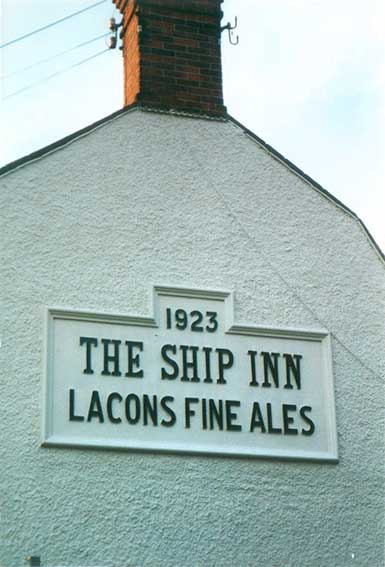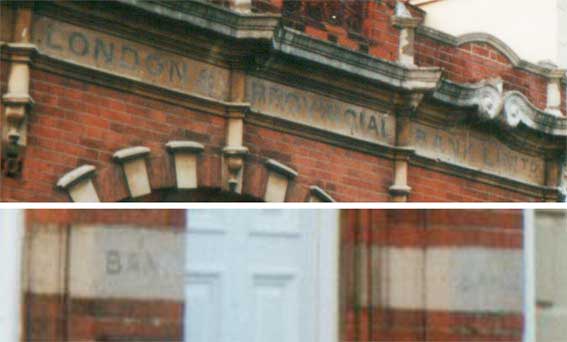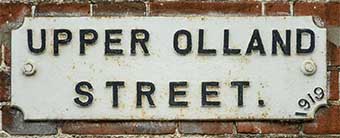Bungay
Bungay on the Suffolk side of the Waveney valley is
proud of its
market-town
charm as well as having at least two fine lettering specimens.
Upper Olland Street
Below we
see the end wall of a public house which preserves name, date and
brewery:
'1923
THE SHIP INN
LACONS FINE ALES'
in a shaped border; clearly a
cared-for
sign. The only part which now applies is the date of erection. The
mixing
of serif caps for the pub name and sans-serif caps for the date and
brewery is
rather
effective.
 2001 images
2001 images
Lacons Falcon Brewery in Great Yarmouth, Norfolk closed
its doors in
1968
after a take-over by Whitbread (themselves no longer brewing these
days)
and the main buildings were soon demolised (the Whitbread depot on
North
Quay). Lacons was a name once associated with a long tradition of beer
brewing
in Norfolk. Drinkers could order a pint of Lacons mild and pale ale or
Oatmeal
stout in a pub around the corner or in a city centre alehouse as far
away
as London and Newcastle. Traces of the Lacons name and falcon motif can
sometimes be found on the walls of old pubs once owned by them, for
example
on The Butchers
Arms,
Knodishall. Our Links
page give the website of the Tiles and Architectural Ceramics Society,
for
more examples.
See also the Links list for
the Brewery History Society website and archive of signs. The Blooming Fuschia public house in
Ipswich is now demolished, but its famous
ceramic sign has been preserved.
Earsham Street
Earsham Street in Bungay could be called rather twee by
the over-critical.
Here are delicatessens, bistros, a real live Post Office (see Cornhill
in Ipswich), ethnic crafts shops and bijou residences.
'LONDON
&
PROVINCIAL BANK LIMTD'
adorns a tiny, ornate former bank branch, now
a
residence. What a strange truncation of the word 'Limited' with its two
stops beneath the 'T' and the 'D'– the sign-maker was probably trying
to fill up the third panel.

See Beccles, Ipswich
Cornhill, Lowestoft and Felixstowe for more bank lettering examples
(none as distinguished as this) and Halesworth
(for a bank that nearly is).

The word 'BANK', very degraded, appears on the stone
pads either side of the entrance.
[UPDATE 9.11.2017: After
sixteen years (two years before this website was launched) we cast our
mind back to pleasant Bungay, prompted by a tweet – something that
definitely didn't exist in those days – from Historic England.
Incidentally, HE is the public body which looks after England's
historic environment, formerly English Heritage, when in 2015 the
government moved the protection of the National Heritage Collection
into the voluntary sector as the 'English Heritage Trust'.
 Historic
England
Historic
England
The photograph of one of the street nameplates in Bungay drew our
attention to the website 'Hidden Commemoration (Waveney valley)
2014-2018' (see Links) and the section Bungay’s Peace Year Street Signs.
Here Michael Atterwill presents a fine gallery of the cartouche-shaped
cast namplates, most bearing the date '1919' curving round the lower
right corner quadrant.
"If you’ve been to Bungay it’s possible you may have noticed these.
It’s equally possible you may have not.
It was decided that Bungay would commemorate the end of the Great War
in 1919 by installing specially commissioned street signs around the
centre of the town. The signs were cast by Rumsby’s Ironworks and
Foundry just off Earsham Street, now no more... All the plates were the
same shape, but for some reason some were more decorated than others.
The winner here is Outney Street, leaving no doubt who was the boss:
'OUTNEY ROAD
A.W. COCKS TOWN REEVE' "
In addition to the '1919', the words 'PEACE YEAR' in an oval
shape appear in the lower portion. That's quite a crammed street
nameplate.]
Home
Return to Historic Lettering from outside
Ipswich
Please email any comments and contributions by clicking here.
Search Ipswich
Historic Lettering
©2004 Copyright
throughout the Ipswich
Historic Lettering
website: Borin Van Loon
No reproduction of text or images without express
written permission
 2001 images
2001 images

 Historic
England
Historic
England